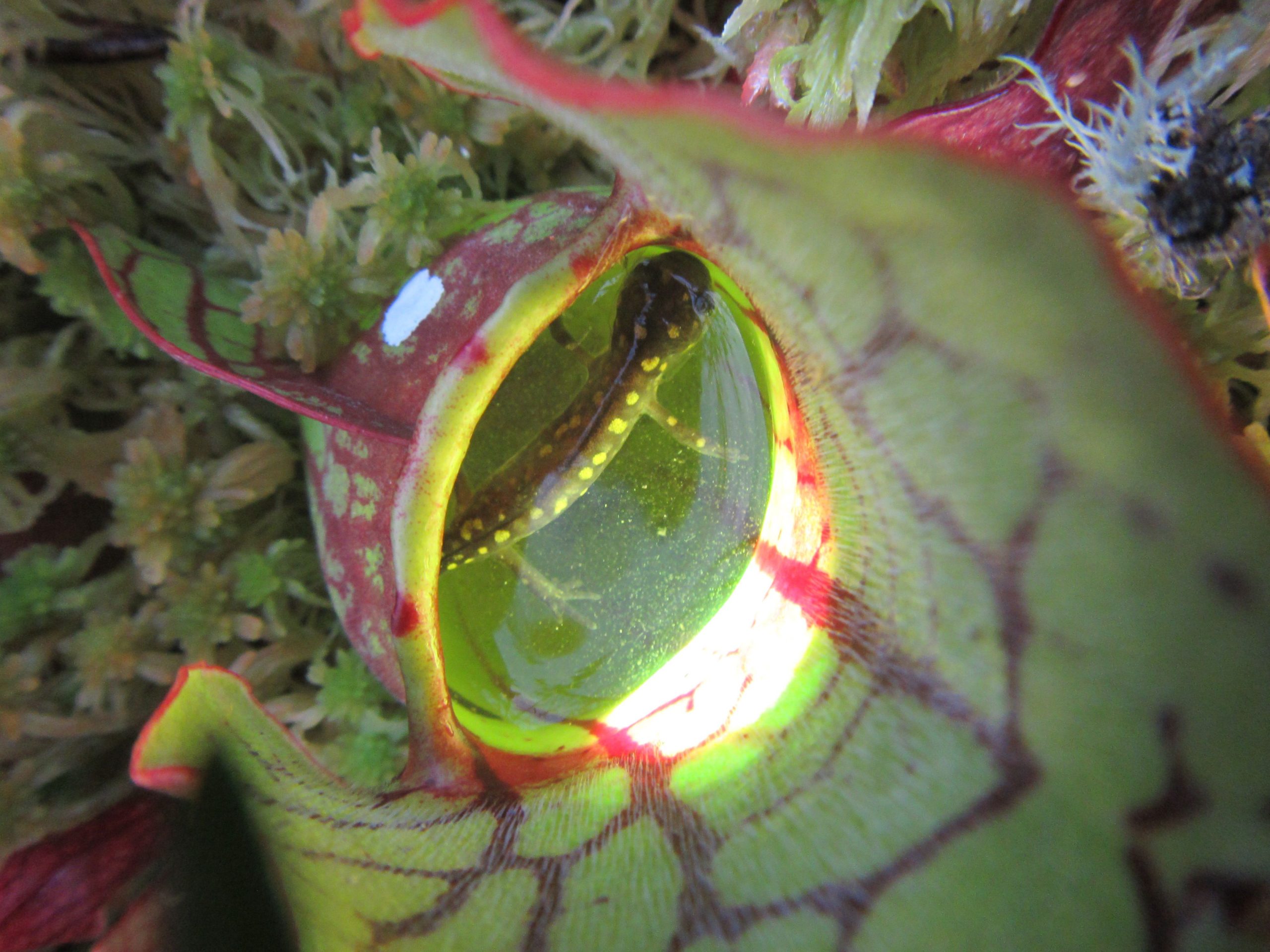In what is believed to be a first in North America, researchers in Canada have found a carnivorous plant consuming salamanders in Ontario’s Algonquin Park wetlands.
Carnivorous plants can still photosynthesize, but to make sure they get enough nutrients, they’ve also evolved a variety of tactics to capture small prey like insects and spiders. Some catch their victims in sticky mucilage or snap traps, for example, while others known as pitcher plants lure prey into bell-shaped leaves full of rainwater, where it eventually dies and decomposes into food for the plant.
Small prey is generally safer for carnivorous plants, which might suffer damage if they bite off more than they can chew. Most rely on a diet of invertebrates, but some of the biggest pitcher plants also trap frogs and lizards. A few species from the Old World tropics have even been known to catch small birds and mammals.
Pitcher Plants with a Taste for Salamanders
According to a University of Guelph paper published in the journal Ecology, researchers found pitcher plants — known to grow in wetlands across the country and eat creatures, mostly insects and spiders — had consumed not just bugs, but also young salamanders.

University of Guelph associate professor and integrative biologist, Alex Smith, called the finding “crazy” and a “surprise.” The discovery was made during an undergraduate field course at the Wildlife Research Station (WRS) in Algonquin Provincial Park in Ontario, Canada, Smith wrote in an email to Global News.
“In preparing these third and fourth year undergraduate students to discover the wonderful world of bogs, I’m going to tell them about carnivorous plants — a common bog adaptation,” he wrote.
“I turned up several pitcher plants (Sarracenia purpurea) to show the students — and in one plant found a young juvenile salamander.”
During the course, Smith said, Patrick Moldowan, a PhD student at the University of Toronto, arrived at the WRS and made the connection that in a previous year’s field course, another student had found a salamander in a pitcher plant.
More work needed to be done
According to Smith, Moldowan returned to the Wildlife Research Station in late August and early September of 2018 and found that 20 per cent of the pitcher plants he surveyed contained at least one young salamander.
On multiple occasions, more than one salamander was observed in a single plant. Each captured salamander was about as long as a human finger, according to the paper.
“This crazy discovery of previously unknown carnivory of a plant upon a vertebrate happened in a relatively well-studied area on relatively well-studied plants and animals,” Smith wrote.
According to the paper, there are a few ways researchers believe the salamanders end up in the pitcher plants. One theory, the paper suggests, is that salamanders seek refuge from predators in the plants. Another possibility, researchers say, is that the salamanders are attracted to the small insect prey in the plants or they may randomly fall into the pitcher plants, becoming trapped.
However, researchers say that the fact that multiple salamanders were found in a single plant on more than one occasion in a “relatively open habitat” suggests that it may be non-random.
“Now that we know what to look for, there are some important questions that we can ask: Are plants a significant form of mortality for the salamanders? Are the salamanders a significant form of nutrition for the plants? Are the salamanders, in fact, not a good thing for the plants?”
No one wants this to happen to salamanders, of course. They’re as cute and charismatic as they are ecologically important, and many species are now in decline due to threats like habitat loss. Feeding native predators is part of their ecological role, though, and while this study does suggest pitcher plants could be “a non-trivial source of mortality for salamanders,” the spotted salamander is still fairly common, with a Least Concern listing from the International Union for Conservation of Nature.
And despite scant evidence until now, spotted salamanders might also be a “substantial nutrient source” for some North American pitcher plants, the study’s authors write, based on the numbers found in purple pitchers during these surveys.
It would be surprising enough if this was discovered in some remote, obscure wilderness. But it happened at one of Ontario’s oldest and most popular parks, located near two major cities (Toronto and Ottawa, Canada) and accessible by a highway.
“Algonquin Park is so important to so many people in Canada. Yet within the Highway 60 corridor, we’ve just had a first,” says study co-author Alex Smith, an integrative biologist at the University of Guelph, in a statement. He describes the discovery as an “unexpected and fascinating case of plants eating vertebrates in our backyard.”
According to Smith, Moldowan will spearhead research to answer these questions this season and in the years to come.
Source:

